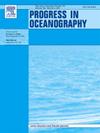Strengthened double-diffusive convection induced by the combined effect of tropical cyclones and a mesoscale eddy
IF 3.6
3区 地球科学
Q1 OCEANOGRAPHY
引用次数: 0
Abstract
Double-diffusive convection (DDC) is a critical driving mechanism for diapycnal mixing in the ocean. However, there is limited quantitative investigation on the impacts of dynamic ocean-atmospheric processes, such as the interaction between tropical cyclones and mesoscale eddies, on DDC generation. In this study, we analyzed the cyclone-eddy induced DDC based on measurements obtained by an underwater glider in the northern South China Sea, where is frequently impacted by tropical cyclones and eddies. We observed abnormally increased salinity and a notable upwelling resulting from cyclone-eddy interaction. Our observations further reveal the coexistence of detached salt fingers (SF) and shear-driven turbulence. Strengthened salt finger dominates DDC with SF-driven salinity diapycnal diffusivity (10−4 m2 s−1) in the deepened halocline, which is an order of magnitude higher than background values. Shear-driven turbulence, characterized by large density overturns below 600 m, is generated due to enhanced geostrophic shear around the eddy. Further investigation indicates that SF thermohaline staircases evolve from lateral saline fronts driven by Ekman-pumping-induced upwelling and Kuroshio intrusion. The convective structure generates strong diapycnal mixing and vertical/lateral salinity fluxes that are urgently needed to be incorporated into estimations of ocean energy/material balance and ocean modeling.
热带气旋和中尺度涡旋共同作用下双扩散对流增强
双扩散对流(DDC)是海洋环流混合的重要驱动机制。然而,关于海洋-大气动力过程(如热带气旋与中尺度涡旋之间的相互作用)对DDC产生的影响的定量研究有限。本文基于南海北部频繁受热带气旋和涡旋影响的水下滑翔机观测数据,对气旋-涡旋诱发的DDC进行了分析。观测到异常的盐度升高和明显的气旋涡相互作用引起的上升流。我们的观测进一步揭示了分离盐指(SF)和剪切驱动湍流的共存。加深盐斜以强化盐指为主,深盐斜的盐指扩散率为10−4 m2 s−1,比背景值高一个数量级。由于涡旋周围地转切变增强,产生了以600 m以下大密度倾覆为特征的剪切驱动湍流。进一步的研究表明,SF型温盐阶梯是在ekman泵送引起的上升流和黑潮侵入的驱动下,由侧向盐锋演化而来。对流结构产生强烈的深环流混合和垂直/横向盐度通量,迫切需要将其纳入海洋能量/物质平衡估算和海洋模式。
本文章由计算机程序翻译,如有差异,请以英文原文为准。
求助全文
约1分钟内获得全文
求助全文
来源期刊

Progress in Oceanography
地学-海洋学
CiteScore
7.20
自引率
4.90%
发文量
138
审稿时长
3 months
期刊介绍:
Progress in Oceanography publishes the longer, more comprehensive papers that most oceanographers feel are necessary, on occasion, to do justice to their work. Contributions are generally either a review of an aspect of oceanography or a treatise on an expanding oceanographic subject. The articles cover the entire spectrum of disciplines within the science of oceanography. Occasionally volumes are devoted to collections of papers and conference proceedings of exceptional interest. Essential reading for all oceanographers.
 求助内容:
求助内容: 应助结果提醒方式:
应助结果提醒方式:


